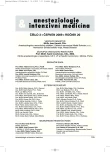Analgosedation in Intensive Care Units (ICU) in the Czech Republic – the results of questionnaire study
Authors:
Černý Vladimír 1; Pařízková Renata 1; Herold Ivan 2; Šrámek Vladimír 3; Novák Ivan 4; Vítková Karolína 1; Kolektiv *
Authors‘ workplace:
Klinika anesteziologie, resuscitace a intenzivní medicíny, Univerzita Karlova v Praze, Lékařská fakulta v Hradci Králové, Fakultní nemocnice Hradec Králové
1; Anesteziologicko-resuscitační oddělení, Klaudiánova nemocnice, Oblastní nemocnice Mladá Boleslav, a. s.
2; Anesteziologicko-resuscitační klinika, Masarykova Univerzita, Fakultní nemocnice u sv. Anny v Brně
3; Interní klinika, Univerzita Karlova v Praze, Lékařská fakulta v Plzni, Fakultní nemocnice Plzeň
4
Published in:
Anest. intenziv. Med., 20, 2009, č. 3, s. 132-136
Category:
Intensive Care Medicine - Original Paper
Overview
Objective:
Study aiming to obtain information on analgosedation regimen on various types of ICUs in the Czech Republic and compare them with data published in similar foreign studies.
Design of the study:
Observational-questionnaire study.
Setting:
Various types of ICU.
Material and methods:
Two-part questionnaire was mailed to members of Intensive Care Medicine Section of CSARIM. The first part of the questionnaire covered use of analgosedation regimens in general, the second part focused in details on protocol sedation used in individual patients treated in ICU during one-day prevalence study (4. 4. 2007).
Results:
Thirty eight ICUs took part in the study. The written analgosedation regimen protocol was used in 7 (19%) of ICUs, protocol for sedation level assessment in 14 ICUs (37%). Use of NMBA (neuromuscular blocking agents) was part of the protocol in 1 ICU, daily sedation breaks was used in 8 ICUs (21%). The most frequently mentioned drugs for sedation were midazolam (in 92% ICUs drug of the first choice) and propofol (in 60% ICUs the second choice), among less frequently used drugs were diazepam, clonidin, tiapride and ketamin, use dexmedetomidin was mentioned in 9 ICUs (23%). The most often used opioids of the first choice were sufentanil (in 76%) and fentanyl (13%), among the opioids of the second choice morphine (52% ICUs) and fentanyl (21%).
Conclusion:
The most commonly used drugs for sedation are midazolam and propofol, for analgesia sufentanil and morphin. Of neuroleptics, tiapride and haloperidol are the most frequently used drugs. Neuromuscular blocking agents are used only rarely. Majority of ICUs participated in questionnaire study do not adhere to specific analgosedation protocol or routine use of sedation level scoring system.
Keywords:
analgesia – sedation
Sources
1. Kollef, M. H. et al. The use use of continuous i.v. sedation is associated with prolongation of mechanical ventilation. Chest, 1998, 114, p. 541–548.
2. Durbin, C. G. Jr. Sedation in the critically ill patients. New Horizons, 1994, 2, p. 64–74.
3. Guldbrand, P. et al. Survey of routines for sedation of patients on controlled ventilation in Nordic intensive care units. Acta Anesthesiol. Scand., 2004, 48, p. 944–950.
4. Martin, J. et al. Practice of sedation and analgesia in German intensive care units: results of a national survey. Crit. Care, 2005, 9, p. R117–R123. Dostupný na www: http://ccforum.com/content/9/2/R117.
5. Mehta, S. et al. Canadian survey of the use of sedatives, analgesics, and neuromuscular blocking agents in critically ill patients. Crit. Care Med., 2006, 34, p. 374–380.
6. Surviving Sepsis Campaign: International guidelines for management of severe sepsis and septic shock: 2008. Crit. Care Med., 2008, 36, p. 296–327.
7. Jakob, S. M. et al. Sedation and weaning from mechanical ventilation: effects of process optimization outside a clinical trial. J. Crit. Care, 2007, 22, p. 219–228.
8. Murdoch, S., Cohen, A. Intensive Care Sedation: a review of current British practice. Intensive Care Med., 2000, 26, p. 922–928.
9. Christensen, B., Thunedborg, L. Use o sedatives, analgesics and neurmuscular blocking agents in Danish ICUs. 1996/97. A national survey. Intensive Care Med., 1999, 25, p. 186–191.
10. Soliman, M. et al.: Sedative and analgesic practice in the intensive care unit: the results of a European survey. Br. J. Anaesth., 2001, 87, p. 86–92.
11. Jacobi, J. et al. Clinical practice guidelines for the sustained use of sedatives and analgesics in the critically ill adult: Sedation and Analgesia Task Force of the American College of Critical Care Medicine (ACCM) of the Society of Critical Care Medicine. Crit. Care Med., 2002, 30, p. 119–141.
12. De Pinto, M. et al. Very-low-dose ketamine for management of pain and sedation in the ICU. J. Opioid. Manag., 2008, 4, p. 54–56.
13. Payen, J. F. et al. Current practices in sedation and analgesia for mechanically ventilated critically ill patients: a prospective multicenter patient-based study. Anesthesiology, 2007, 106, p. 687–695.
14. Pisani, M. A., Murphy, T. E., Araujo, K. L. et al. Benzodiazepine and opioid use and the duration of intensive care unit delirium in an older population. Crit. Care Med., 2009, 34, p. 177–183.
15. Wesley, E. E. Identification Delirium in the ICU: practical points and lessons learned. Sborník sympozia Delirium management: Evidence for Change and Future Directions, 1.2. 2009, Gaylord Opryland Resort and Convention Center, Nashville, Tennessee, USA.
16. Sacerdote P: Opioid-induced immunosuppression. Curr. Opin. Support Palliat. Care, 2008, 2, p. 14–18.
17. Weinert, C. R., Kethireddy, S., Roy, S. Opioids and infections in the intensive care unit should clinicians and patients be concerned? J. Neuroimmune Pharmacol., 2008, 3, p. 218–229.
Labels
Anaesthesiology, Resuscitation and Inten Intensive Care MedicineArticle was published in
Anaesthesiology and Intensive Care Medicine

2009 Issue 3
Most read in this issue
- Analgosedation in Intensive Care Units (ICU) in the Czech Republic – the results of questionnaire study
- Delirium during the postoperative period and in the intensive medicine
- Catheter-related blood stream infections
- Dynamic parameters of preload in pressure support ventilation
